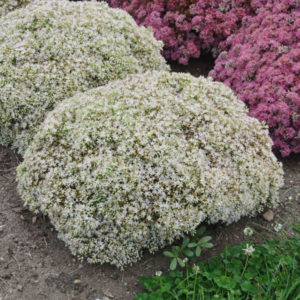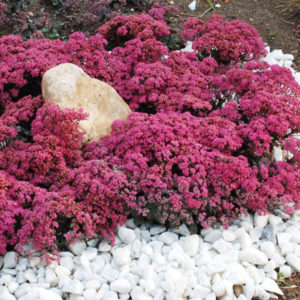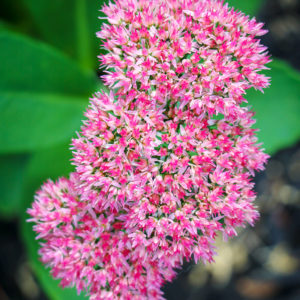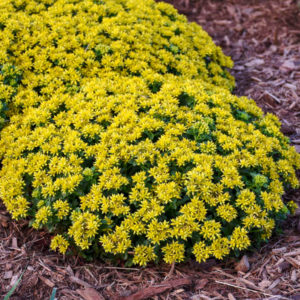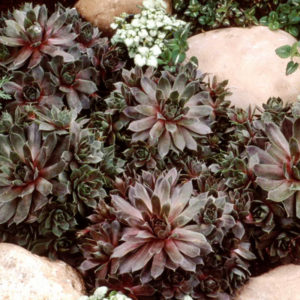Over the past decade, succulents have become beloved foliage plants for indoors and outdoors. Succulents have trended as indoor plants used for wedding favors, kitchen decor, and even wall art. House plant enthusiasts also love the variety that succulents offer for the sunny shelves and hanging planters. Succulents aren’t just for indoor decor, they provide color and texture in the landscape as well. One of the most popular types of succulents for the landscape is sedum. Perhaps you have grown sedum indoors in pots, but want to grow sedum outdoors in the landscape. Our complete guide to growing sedum will help answer all your sedum questions.
Growing Sedum in the Landscape
Who should plant Sedum?
Anyone with a sunny garden and a flair for texture in the garden should plant sedum. Sedum plants are easy to grow perennials for new gardeners who have a lot of sun on their property. People who are searching for drought-tolerant plants for their landscape will certainly want to add a few varieties of sedum to their garden.
Where does Sedum grow best?
Sedum are succulent plants. Succulents are plants that store excess moisture in their roots, leaves, and stems. Due to how they store moisture, sedum similar to most succulents requires dry soil. The best place to grow sedum in your landscape is a full sun location with well-draining soil. Sedum can be grown in a range of climates, and even though they look exotic many are winter hardy.
How to grow Sedum?
Common ways to plant sedum are from potted plants or bare root. Sedum can also be divided from an established planting area to add more to other areas of your yard. Planting sedum from leaf cuttings is also common, however, it is a much slower way to grow sedum in the landscape. Planting sedum from pots or bare roots is the preferred way to plant these succulent perennials. Bare root sedum are a new edition to the Holland Bulb Farms selection of bulbs and perennials.
Since sedums are tolerant of hot and dry conditions planting them from a bare root can occur from spring through summer. Bare root sedum can be planted directly into the ground. You can also start your bare root sedum in pots and then transplant them to the ground when the top growth is more established.
Plant the roots of sedum just below the soil surface. The crown of the roots, which is where all the roots come together and the plant will grow should be at or above the soil level. Spread the roots out when planting, making the planting hole a bit wider than it is deeper.
Do all Sedum spread?
Sedum are often planted to be used as a ground cover in sunny areas such as rock gardens. However, not all varieties of sedum are grown as ground covers. Upright varieties of sedum like Autumn Joy Sedum, Powder Puff Sedum, Night Embers Sedum, and Frosted Fire Sedum do not spread. These upright varieties have a clump or mound-forming habit and will stay neat and tidy in their appearance.
Ground cover sedum varieties like Dazzleberry Sedum, Firecracker Sedum, and October Daphne Sedum are often planted in rock gardens and boulder walls. These creeping types of sedum also are fun plants to add to a container. Creeping sedum varieties can be planted in a pot where you want the foliage to spill over the edge. I have a couple animal planters (owls and frogs) and have used sedum in the planters to create the look of hair on these fun animal planters.
How fast does Sedum spread?
A rule of thumb when planting perennials is the first year they sleep, the second year they creep and the third year they leap! This is true when planting ground cover sedum in your garden. It may take up to 3 planting seasons for the sedum to fill in and cover the area completely.
Do Sedum have flowers?
Sedum have interesting foliage and are often planted for the texture and color of the foliage. However, many varieties of sedum have showy flowers in mid-to-late summer. Sedum bloom in shades of pink, purple, white, and yellow. Their colorful flowers combined with colorful foliage make them garden gems with long-lasting seasonal interest.
Autumn Joy Sedum is the most well-known upright variety of sedum. It is low maintenance and has rosy pink flowers late summer that turn to rosy red flowers in early autumn. Little Miss Sunshine Sedum is a low mound forming sedum with bright yellow flowers mid-to-late summer. This low-growing variety of sedum can be grown in the front of a planting bed, and it also works well in a rock garden. Bundle of Joy Sedum is another low mound forming variety with a blanket of white flowers all summer. Super Star Sedum is a stand-out variety with bright magenta flowers on frosted green foliage. It maintains a nice mound habit and also looks good planted in the front of a garden border.
Are Hens and Chicks a variety of Sedum?
Hens and Chicks are unique succulents that are often sold alongside sedum. These low growing plants that form rosettes of leaves are from the genus Sempervivum and not the genus Sedum. Therefore, even though Hens and Chicks are often planted and sold together they are not sedum. They will grow in hot, dry conditions and are lovely when planted in rock gardens, planters, and boulder walls. Hens and Chicks are hardy in zones 3-8 and do best planted in full sun, and soil that drains well.
Fun Foliage for Sunny Hot Gardens
My favorite feature of sedum is the foliage. As mentioned above all varieties will produce flowers, and in some instances, the flowers may be the reason you grow them. However, the different colors of texture from lime green sedum, to variegated sedum to purple sedum can help create interest in the garden from spring through fall. Adding foliage to the garden is one of my favorite ways to diversify the plants in your garden. Whether it is adding foliage to a sunny rock garden with sedum or a shaded garden corner with hosta, the impact of foliage color and texture should not be overlooked.


